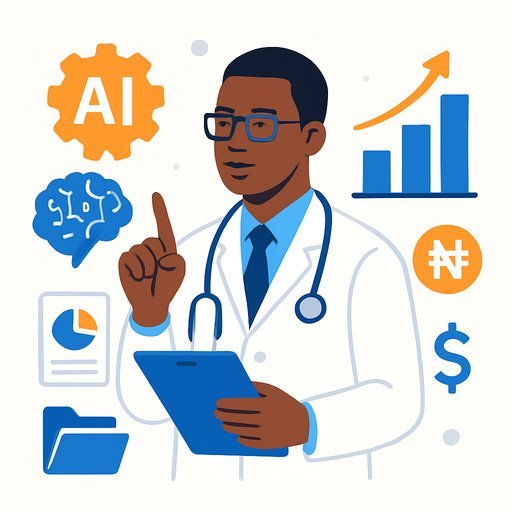Healthcare's unstructured data is the next big lever for outcomes and growth
Here's the simple truth: most of your clinical signal is still trapped in free text, PDFs, images, and scanned reports. That's the 80% of data your systems don't see, but your clinicians rely on every day. AI-especially modern language and vision models-makes that data computable at scale, turning notes into structured context you can act on.
As one founder in the space, Saksham Arora of Savant Bio, put it: the most critical clinical information-clinical reasoning, patient narratives, symptom context-has lived as "dark data" in free-text notes. LLMs can finally read it, summarize it, and route it to the right workflow without adding burden to clinicians.
What this means for care delivery and operations
- Higher-quality documentation and faster chart review with AI summaries grounded in the full record.
- Smarter decision support that understands context, not just codes and lab values.
- Cleaner handoffs across teams because narratives are surfaced as structured insights.
- More accurate risk adjustment, prior auth, and coding with fewer denials.
- Better research inputs: real-world evidence that reflects what actually happens in clinics, not just claims.
Where India is moving now
Health tech start-ups like Eka Care, HealthPlix, and Axone Health are building around this opportunity. Even though India had only eight AI-driven healthcare companies in 2024 (up from two in 2011), the pace and focus are improving.
Global Capability Centers (GCCs) are doubling down on digital, AI, and data. Eli Lilly is opening a second GCC in Hyderabad with AI, automation, cloud, and product engineering-about 1,500 new roles. Bristol Myers Squibb launched a USD 100 million innovation hub with 1,500 specialists. Amgen opened a USD 200 million technology and innovation center focused on AI and data science. Sanofi is investing EUR 400 million to nearly double its Hyderabad GCC headcount to 2,600 by 2026. Novo Nordisk is expanding its Bengaluru hub by 16% to 5,000 employees.
Pharma value chain is being rewired
AI is now embedded across discovery, development, supply chain, and commercialization. You're seeing AI-driven molecule design, predictive diagnostics, virtual clinical trials, and real-world data analytics-all built on better data pipelines. The incentive is clear: speed, precision, and cost efficiency from bench to bedside.
Market outlook: the scale is real
The Indian pharma market is estimated at Rs 4,71,295 crore (USD 55 billion) in 2025, with projections of Rs 10,28,280-11,13,970 crore (USD 120-130 billion) by 2030. With national growth targets of a USD 30-35 trillion economy by 2047, pharma's global footprint and partnerships with MNCs, biotech, and academia will remain a core growth driver.
How healthcare leaders can execute now
- Data readiness: Standardize intake, reduce scans where possible, and adopt FHIR for interoperability.
- Privacy and security: Automate de-identification and PHI controls. Align to frameworks like the NIST AI Risk Management Framework.
- Clinical validation: Evaluate models on real workflows-note quality, error types, and escalation behavior. Always include a human-in-the-loop for critical decisions.
- Procurement discipline: Favor vendors with clear grounding techniques, audit trails, and measurable ROI (time saved per note, denial reduction, improved throughput).
- Talent and training: Upskill clinicians, data teams, and IT on NLP, prompt best practices, and safe deployment.
- RWE and research: Build de-identified corpora for outcomes research and quality improvement; align with IRB and governance early.
- Build vs. buy: Use off-the-shelf for summarization, coding assist, and intake; build in-house where proprietary context is the advantage.
Practical use cases to pilot in 90 days
- Ambient scribe and note summarization in high-volume specialties.
- AI-assisted discharge summaries and referral letters.
- Prior authorization prep with evidence extraction from notes and imaging reports.
- Safety netting: identify high-risk patients from free-text symptom narratives.
- RWE cohorts pulled from notes, labs, and imaging impressions for QI studies.
Metrics that matter
- Clinician time saved per encounter and after-hours charting reduction.
- Note completeness and accuracy (peer-reviewed samples).
- Denial rates, turnaround time for prior auth, and appeal success.
- Readmissions, LOS, and follow-up adherence where interventions apply.
- Patient experience scores tied to communication and continuity of care.
Why this is a timely window
The technology is ready, the data exists, and the business case is straightforward: convert unstructured clinical context into structured signals that improve care and cash flow. Health systems that move first will set the data standards others adopt. Those that wait will inherit them.
Next step
If your teams need practical training on LLMs, data workflows, and AI safety for healthcare operations, explore role-based programs here: AI courses by job. Keep it simple: pick one workflow, measure hard outcomes, and scale what works.
Your membership also unlocks:






